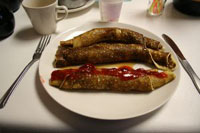There is much to explore when it comes to Norwegian cuisine. Although primarily consisting of fish and game, the food in Norway also consists of fresh ingredients found in different parts of the country such as the wilderness, mountains and coastline. Today the country has produced some of the best international chefs and has a host of restaurants offering local specialties and classic dishes. No gastronomical journey through Norway is complete without trying these 5 foods.
Bacalao
Bacalao means cod in Spanish. It was used to refer to fresh cod that was fully salted and exported to European countries.In Norway, Bacalao is the name for a delicious seafood casserole made with klippfisk (salted cod), tomatoes, potatoes, olives, garlic, onion and oil. The fish is watered out for a couple of days beforehand to reduce the saltiness. The dish has become especially popular in Northern Norway since the 90s. It is commonly served at dinner parties and most restaurants in the country feature it on their menu. There are many different recipes for Bacalao in Norway, but all are cooked with codfish as the main ingredient. Lofoten in Nordland has its own recipe called Lofotlao. Bacalao is immensely popular in the town of Kristiansund where cayenne pepper and sweet peppers are added to the recipe.
Smalahove
Lamb is a part of many Norwegian recipes and there is a tradition of using every part of the animal. Smalahove is a western Norwegian dish made with sheep’s head, which has been salted, smoked and dried. It is then boiled or steamed and served with accompaniments of potatoes and mashed rutabaga. Smalahove used to be a peasant dish, but today it is enjoyed as a delicacy and eaten during the colder months. While Smalahove might be a cause for culture shock in some people, others have found it quite tasty. It is considered to be somewhat of an ‘extreme’ food and is popular with thrill-seeking tourists. But do remember that it was originally an authentic rural dish and a staple in peasant homes.
Pinnekjøtt
Pinnekjøtt consists of dried, salted or sometimes smoked lamb ribs. It is a common main course dish especially in the northern and western region. It features regularly at social gatherings and during weddings and Christmas celebrations. Side dishes like potatoes and pureed rutabaga often accompany Pinnekjøtt. When Pinnekjøtt is made at home, the lamb racks are cured with sea salt or brine. They may or may not be smoked after curing, and are then left to cool and dry. The ribs are separated, soaked in water to get rid of excess salt and then steamed over water. Pinnekjøtt is easily available in supermarkets today especially before Christmas.
Kjøttkaker
Kjøttkaker are Norwegian meat cakes and have a similar taste and texture to Swedish meatballs. They are shaped like patties and eaten as appetizers or part of the main course. Kjøttkaker are served in brown gravy that is packed with spices like allspice, nutmeg and ginger. The unique taste of the gravy comes from the caramel-flavored brown cheese, called Brunost, which serves as one of the main ingredients. It is blended with meat stock, cream and sometimes even some cocoa powder. Brunost is made from the leftover whey in the process of cheese production. The whey is boiled down and what’s left is an almost fudge-like sweet cheese.
Kransekake
Kransekake is a classic Norwegian and Danish sweet that is served on weddings and other special occasions. It is prepared by layering concentric rings of cake on top of each other to create a tall cone-shaped structure. There may be up to 18 or more layers of cake held together with icing. The cake itself is made with sugar, almonds and egg whites. This marzipan mixture is formed into rings and baked to create a sweet treat with an outer crust and a soft almond-flavored filling. The cakes are decorated with a drizzle of icing and stacked. Decorations like small Danish flags may be placed into the cakes. Kransekake was originally called overflødighedshorn and was served at weddings in the shape of a cornucopia filled with small treats like chocolates and biscuits. Some even place a bottle of akvavit or wine inside.

